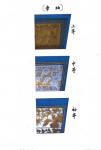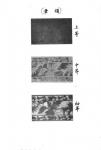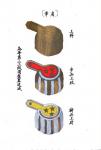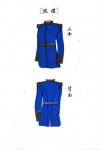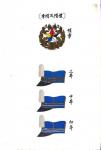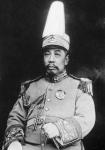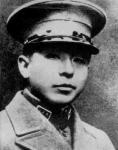-
Posts
851 -
Joined
-
Last visited
-
Days Won
3
Content Type
Profiles
Forums
Blogs
Gallery
Events
Store
Everything posted by drclaw
-
Here are some spectacular images of the uniforms and flags of the early Republic taken from the original Decree Number 19 issued by President Yuan Shikai in 1912. Thanks heaps to Dieter for his help in tracking this down. He deserves a Golden Kite First Class for this! Nick, these are for you!
-

Persia - Order of the Lion and the Sun
drclaw replied to drclaw's topic in Middle East & Arab States
Welcome back Markus! You've been missed. Luckily you have an iPad that you can carry photos of lions with you wherever you travel. -
I'm not sure about Yong Zeng but Lao Tian Di's cloisonne vases, tea sets, etc, certainly did. Have a look at this excellent website on Lao Tian Di's cloisonne ware. It's an example "our" hobby crossing over to decorative arts. We always knew that our bling were works of craftsmanship! http://www.idcloisonne.com/archivedcloisonnestudies/id8.html
-
And here are some notes on Lao Tian Li that I compiled from various sources. Lao Tian Li and Chinese Cloisonne Cloisonné is an ancient technique for decorating metalwork, in recent centuries using vitreous enamel, and in older periods also inlays of cut gemstones, glass, and other materials.[1] The decoration is formed by first adding compartments (cloisons in French) to the metal object by soldering or adhering silver or gold wires or thin strips placed on their edges. These remain visible in the finished piece, separating the different compartments of the enamel or inlays, which are often of several colors. Cloisonné enamel objects are worked on with enamel powder made into a paste, which then needs to be fired in a kiln.[2] The technique was in ancient times mostly used for jewelry and small fittings for clothes, weapons or similar small objects decorated with geometric or schematic designs, with thick cloison walls. In the Byzantine Empire techniques using thinner wires were developed to allow more pictorial images to be produced, mostly used for religious images and jewelry, and now always using enamel.[3] By the 14th century this enamel technique had spread to China, where it was soon used for much larger vessels such as bowls and vases; the technique remains common in China to the present day, and cloisonné enamel objects using Chinese-derived styles were produced in the West from the 18th century.[4] Chinese cloisonné began appearing in Yuan Dynasty in the 14th century and soon became a luxury good adored by the court. During Ming dynasty, the emperors funded shops in Beijing to serve exclusively to the royal courts and nobles. Since most cloisonné made during this period were in blue color, Chinese cloisonné was given the name Jingtai Blue.[5] The imperial obsession with cloisonné reached its height during the Qing Dynasty, especially under the Kangxi and Qianlong emperors. The Imperial Court hired and trained highly skilled artisans to work on cloisonné and the technology was pushed to new heights. At this time, cloisonné remained a luxury good available to only the very few people at the top of the social class.[6] With the decline of China’s economic and political power during the late 19th and early 20th century, however, the late Qing Emperors could no longer fund imperial cloisonné shops. Having lost imperial patronage, skilled cloisonné artisans were forced to find new ways to make a living. They founded their own commercial shops, focusing on making cloisonné products that could be sold more widely. Their products moved away from luxurious decorative items to more functional and practical items.[7] There were several famous cloisonné shops during this period, such as Lao Tian Li, De Xing Cheng, Bao Hua Sheng, Jing Yuan Tang and Zhi Yuan Tang. At the beginning, products followed traditional Chinese art trends and values. But they soon evolved to catering also to western styles and flavors. This style of cloisonnes was made mostly for exporting.[8] Little is known about Lao Tian Li (lit. "Old Heaven Advantage / Profit"), a fine Chinese cloisonne craftsman. Lao Tian Li is more likely his business name. It is believed that Lao Tian Li operated his own studio in Beijing during the early 1900s to 1930. He may have been a former Imperial cloisonne craftsman or he may have employed Imperial craftsman after the Imperial kiln was closed before the end of the Qing Dynasty.[9] In 1904, an incense burner made by Lao Tian Li was showcased in Chicago World Expo and won first prize. This event brought the name of Chinese cloisonné to thousands of American households and triggered a much bigger wave of Chinese cloisonné exporting.[10] There is also documentation that he participated in the San Francisco Pacific Panama International Exhibition in 1915, shortly after the establishment of the Chinese Republic. [11] Lao Tian Li's workshop in Beijing was commissioned to produce cloisonné Orders for the new Republic and he may also have produced samples of the late Qing Orders of the Coloured Dragons (these were established in March 1911 but were never conferred). His insignia were of high quality. For example, his Striped Tigers are richly detailed with delicate cloisonne work. They display, in my opinion, the highest craftsmanship of all the manufacturers perhaps surpassed only by the few Striped Tigers produced by the Japanese Mint at Osaka. Gavin [1] ‘Cloisonne’, Wikipedia. [2] Ibid [3] Ibid [4] ‘A Quick Look at Chinese Cloisonne’, March 2011, http://www.mycrystal...tml#dexingcheng [5] Ibid. [6] Ibid. [7] Ibid. [8] Ibid. [9] Lisa Duchesnay, ‘Lao Tian Li – Important Qing Dynasty and Republic Producer’, 2009, www.idcloisonne.com [10] ‘A Quick Look at Chinese Cloisonne’, March 2011. [11] Lisa Duchesnay (2009) [12] Lisa Duchesnay (2009). [13] Ibid. [14] Ibid.
-
Two frequently encountered manufacturers of the early Republic Orders are Yong Zeng and Lao Tian Li. Their manufacturer stamps, often found on the reverse of the insignia they made, were posted by Nick in "Striped Tigers and their marks": http://gmic.co.uk/in...nd-their-marks/ First up, Yong Zeng. Some writers have described Yong Zeng as a manufacturer in Guangdong (Canton) Province who also produced insignia for the Guomindang Government of Sun Yat-sen / Chiang Kai-shek. Others described him as Superviser of the Beijing Mint. Neither of these theories are correct. JCwaters has provided a detailed history in Mandarin which I've had professionally translated to share. Thanks JC! Yongzeng Military Clothing Store The Yongzeng Military Clothing Store located on the north side of the Polishing Factory Road outside Qianmen (currently named “West Polishing Factory Street”) was a large company enjoying great popularity in Beijing before “the Marco Polo Bridge Incident” happened in 1937. The Yongzeng Military Clothing Store had over 40 affiliates in Beijing, Tianjin, Shenyang, Xi'an, Shanghai and other cities including machine factories, chain belt factories, badge factories, timber mills, steel rolling mills, old-style private banks, banking houses, silk and satin stores, leather goods and foreign goods stores, and employed seven or eight hundred staff. 1. Starting from A Small Hat Store The founder of the Yongzeng Military Clothing Store was FENG Yongxiu from Shen County, Hebei Province. He came to Beijing at the age of 15 or 16 and worked as an apprentice in a hat workshop outside Chongwenmen. After he finished the apprenticeship, he started producing all kinds of cotton hats and promoted them in many different stores. The hats made by FENG Yongxiu were good and cheap, so they were in high demand and the business was booming. Later, FENG Yongxiu and a person called GAO Zengyuan jointly funded and opened a hat store named “Yongzenghe Hat Store” outside Qianmen. The word “Yong” stands for “FENG Yongxiu " and the word “Zeng” stands for “GAO Zengyuan”. The “Boxer Incident” in the year of Emperor Guangxu 26 happened shortly after the store was opened, and the store was burned down. FENG Yongxiu and GAO Zengyuan felt helpless. They had no choice but to go back to their hometowns respectively. After the Qing government signed an unequal treaty named “Boxer Protocol ”with eleven imperialist countries including Britain, the United States, Germany, France, Russia, Japan, Italy, Austria, Belgium, the Netherlands and Spain in 1901, the Eight-Power Allied Forces withdrew and calm was restored in Beijing. FENG Yongxiu returned to Beijing and raised a fund from friends, people from the same village and business people. He returned to his old trade and opened a small hat store on the north side of the western section of the Polishing Factory Road outside Qianmen. He changed the previous name “Yongzenghe” to “Yongzeng”. FENG Yongxiu was good at management and focused on the quality of his products, especially the brand name of “Yongzeng”. Therefore, the Yongzeng Hat Store won a high reputation in the community and the business was very prosperous. 2. Transforming into a Military Clothing Business In the last years of Emperor Guangxu of the Qing Dynasty, a new official called WANG Shizhen was appointed as the head of the Division of Military Training for New Recruits in the Qing government, who was FENG Yongxiu’s old friend. FENG Yongxiu’s relationship with Wang Shizhen helped him get a purchase order for a small amount of uniforms. He made a very good profit after he delivered the uniforms. After that, FENG Yongxiu changed the Yongzeng Hat Store to the Yongzeng Military Clothing Store in 1908. The store offered wholesale products rather than retail products and was designed to sell products in bulk quantities for large orders. Yongzeng Military Clothing Store was the first store of its kind and was the only one in Beijing. FENG Yongxiu was very good at socialising and made a lot of friends in different factions of the Beiyang Army. For these reasons, the Yongzeng Military Clothing Store received a lot of bulk orders for military uniforms and the business grew rapidly. The Yongzeng Military Clothing Store enjoyed a high reputation in Beijing. Especially in the military and police communities, everyone knew the Yongzeng Military Clothing Store in Beijing. 3. Yongzeng at its Peak Over the twenty years from 1912 when the Republic of China was founded to 1937 when the "Marco Polo Bridge Incident" happened, the Yongzeng Military Clothing Store had reached its peak of the development in history. Yongzeng set up a military clothing factory in Beijing and employed about a hundred workers. It also set up iron factories to produce sabres, military swords and military equipment, leather goods factories, old sheepskin factories, tanneries, dyeing factories, embroidery factories, silverware factories, silk braid factories, inner garment factories, steel rolling mills, glassware factories, etc. Everything that an army needs such as soldiers’ military uniforms, military caps, military boots, military officers’ uniforms, sabres, officers’ sabres, walking swords, warhorses’ saddles, military camping tents, military camping beds, kettles, buckets and meal boxes could be produced and provided by Yongzeng, in order to meet supply demands. In order to generate more business from the troops stationed outside Beijing, Yongzeng set up offices, factories and stores in Tianjin, Xi'an, Shenyang, Taiyuan, Qingdao, Shanghai and other places. In addition to the military uniform store, FENG Yongxiu opened more than 40 businesses including the Duomao Banking House, the Yongzenghe Private Bank, the Yongzeng Silk, Satin and Foreign Goods Store, the Yimau Silk and Satin Store, the Yongyu Food Store and the Yongshou Coffin Store. FENG Yongxiu had a personal relationship with many dignitaries in the military and political circles such as YUAN Shikai, DUAN Qirui and WU Peifu. FENG Yongxiu was an important person in the business sector in the Republic of China and he enjoyed an extremely prominent status. However, dozens of small and medium-sized military uniform stores were opened in the military clothing industry in the Republic of China, which broke the situation that Yongzeng Military Uniform Store was the only one in the market. After 1912, over 20 stores were opened in Beijing, including the Yongchanglong Military Clothing Store, the Huachang Military Clothing Store and the Weicheng Military Clothing Store. In addition, more than ten businesses with “military clothing stores” were opened in Tianjin, which supplied military equipment for armies. The emergence of these rivals took away a lot of business from the Yongzeng Military Clothing Store. However, FENG Yongxiu was good at managing people and the business, so he was always the winner when competing against his rivals in the industry and became the number one choice in the military clothing industry. The military clothing for armies was seasonal. Winter clothing was ordered in autumn while the summer clothing was ordered in winter. For this reason, the machine wasn’t used in the military clothing store when there was no order. However, once an order was placed, it was always urgent and the products should be delivered within the deadline. Therefore, if the military clothing store hired more workers and they earned wages when there was no work, the military clothing store would lose money. If it hired fewer workers, the workers wouldn’t be able to manage their workload when an order for thousands of or tens of thousands of uniforms was placed. The Yongzeng Military Clothing Store’s solution was that the managers in its stores and factories were permanent employees. A small portion of skilled workers were permanent employees. Most workers were temporary employees. They came when there was work and left when there was no work. The temporary employees were paid on a piece-rate basis. No matter what project it was, they would be paid by the piece. There were three kinds of workers in the Yongzeng Military Clothing Store. The first kind of workers didn’t have any machine or tools. The second kind of workers had sewing machines and tools. They earned wages and received the monthly payment for machine rental. The third kind of workers didn’t need to work in the factories. They took the raw materials home instead and delivered the products when they were done. They would also receive the payment for their machine. Since the Yongzeng Military Clothing Store adopted the system where the permanent employees led most of the temporary employees, it not only reduced the expenses and the amount of equipment, but also ensured the quality of the products and on-time delivery of the products. 4. The Decline of the Yongzeng Military Clothing Store After the “Marco Polo Bridge Incident” in1937, the puppet regime established by Japan ruled Beijing. All the military clothing of the Japanese army was centrally distributed by the military authority of Japan in North China. The Yongzeng Military Clothing Store and the other military clothing stores in Beijing could only get purchase orders for military clothing and uniforms from the army of the puppet regime, postal service companies and railway companies, or undertook some jobs as retail outlets. The business of the Yongzeng Military Clothing Store went down sharply. After FENG Yongxiu died, his son FENG Xinchuan took over the business. The business of the Yongzeng Military Clothing Store went worse. After the founding of the People’s Republic of China in 1949, Yongzeng changed its trade and started producing working tools and protective equipment. In 1956, it participated in a public-private partnership. In 1958, it was merged and the plaque of “Yongzeng” was removed. The Yongzeng Military Clothing Store came to an end in history.
-
Thanks for posting these Nick. Those eczema cream boxes aren't very pretty are they. I corrected my earlier post where I suggested that #81-92 were Lao Tian Li. They are more likely Yong Zeng after all and very similar in appearance to #121-123. I have finished my translation of JC's history of Yong Zeng which I will post in a separate topic together with a history of Lao Tian Li that I compiled.
-
Hey Nick, I was marvelling at these photos again. Do you know the name of this chap in post #34, photo 22? He looks like Mr Creosote squeezed into the uniform of a Chinese warlord!
-
Hey Nick, I don't believe I've come across dermatin boxes before. Would you have any images to share? I even Googled "dermatin" it comes up with an ointment for eczema :lol:
-
Hi there gents, Thanks for all this fascinating information. I'm loving this thread! Interestingly, the red enamel reverse is very similar to that found on some of the Qing Empire Orders of the Coloured Dragons, whose design inspired the Republican Order of the Golden Grain (which also have enameled reverses on the badges but not stars). A possible theory is that the ones with the red enamel reverse were early pieces, inspired by the Qing Coloured Dragons, which I suspect he might also have manufactured. Subsequently, as he became more established in manufacturing Orders, he began stamping his mark on the reverses. Insignia from some of the other manufacturers are of noticeably poorer quality with the tigers appearing "painted" as opposed to carefully laid cloisonne enamel. #103-104 clearly demonstrate this. JCwaters has provided me a very detailed history of that other frequently encountered maker, Yong Zheng. The 2008 UBS Tammann catalogue describes Yong Zheng as a Guangdong (Canton) manufacturer who also provided Striped Tigers to the Guomindang Government of Sun-Yat Sen and his successors which bestowed the order from 1921 to about 1927. The Tammann catalogue mentions that the Guangdong insignia frequently have lower-grade enamel with a tendency to decay ("enamel pest"). Other references however describe Yong Zheng as the Supervisor of the Beijing Mint. I'm in the process of translating JC's history and will post it up when I do. The mysterious "7XII" mark appears with the Yong Zheng insignia in the Tammann catalogue and going back through the earlier posts on this topic other numbers marked on Yong Zheng insignia include "8XI" "9I" and "X6". These could possibly be dates, batch numbers or the makers marks of individual craftsmen in the Yong Zheng workshop. My initial view was that these digital marks are unique to Yong Zheng. HOWEVER, Li Gongqing's book has a Lao Tian Di First Class set with both the sash badge and breast star bearing the Lao Tian Di and "7XII" stamps on the reverse. This would disprove the theory that these were batch numbers or markers marks. Given the presence of the stamps, I would assume the sash badge in Li's book has a metal reverse as opposed to red enamel. The set is accompanied with a red with yellow edge sash (which indicates an early award, later awards had a sash similar to the Second Class, i.e. yellow with green edges) and a black lacquer case. Li's book has another First Class set (with the red sash and black lacquer case). The depictions of the tigers are absolutely beautiful and by far the most realistic looking I've ever seen for this award. This would appear to be one of the rare Japan Mint specimens going by the higher quality black lacquer case and finer quality inscriptions which appear more Kanji than Hanzi. One question I have is the cases. Some are cloth like the Lao Tian Di example in #103. Others are black lacquer. Is there a reason for the variation? Gavin
-

Uncertain South-East Asia decoration, any Ideas?
drclaw replied to paul wood's topic in South East & East Asia
Paul, this is a real mystery. The two snakes appear to be "Naga", deities in the form of great snakes in Hindu or Buddhist traditions. My guess would be South Asia, Nepal, Bhutan, or possibly Indo-China. The chaps on SA Gongs might be able to identify the motif. Gavin -
Very nice Brian, thanks for sharing. Congratulations on a great pick up! Gavin
-
Gents, The Red Cross medals (Manchukuo, China, Wang Jingwei puppet regime, etc) have always been a mystery to me. But this thread hits it all on the head. Thanks so much for taking the time to share. Gavin
-
Thanks Nick. Could you provide a little more information on the source of this document / list of recipients? It would be great to know for historical research, e.g. how much weight we could attach to the list. It's a fascinating list nonetheless. Zhang Xueliang (son of Zhang Zuolin, the warlord of Manchuria) received the #1 award according to the list. Zhang has become a popular hero. He joined the Nationalists following the assassination of his father by the Japanese and sought to eliminate Soviet and Japanese influence. He kidnapped and imprisoned Chiang Kaishek in April 1936 (the "Xian Incident") to force him to agree to a popular front to fight the Japanese. Chiang never forgave Zhang for his insolence and Zhang spent over 50 years in house arrest. He moved to Hawaii in 1993 and died in 2001 at the grand old age of 100. He lived not only to see the emergence / development of Taiwan, but also China. http://en.wikipedia.org/wiki/Zhang_Xueliang
-
Wow Nick, thanks for the images and the absolutely fascinating list of recipients. So Chiang did receive #7, which only deepens the mystery of the whole "Special One" award that the photograph depicts him wearing.
-
Thanks very much David, I'm glad the book arrived safe. Thanks also for the extra contribution for postage. It was very thoughtful of you and much appreciated. Cheers, Gavin
-
Thanks Nick, Dieter and Lambert. It's been the support and encouragement of friends like yourselves that made it so much more enjoyable. All the best, Gavin
-
VERY interesting Nick. Thanks for posting all these images and thoughts. To my mind, the issue breaks down into two questions: (1) Is the insignia genuine? (2) Did this insignia belong to Chiang Kai-shek? There appears to been little debate on (1). (2) rests on two contentions: First, the reverse inscription of "Special One". It is a strong argument that if anyone might have received a "Special One", it was the Generalissimo who instituted the Order. It also matches the photograph which shows the reverse of the medal on Chiang. The Taiwan Government has not disputed the claim that an award marked "Special One" was made to Chiang. Only that it was buried WITH him. (Awards of Republic of China Orders were numbered so there would have been a central register of awards and recipients. If these records were evacuated to Taiwan after the Civil War, they should confirm or disprove this.) Which brings us to the second contention: "Before 1995, it was the usual practice to give a new set of the medals to a general who passed away for burial," appears to be a conveniently neat explanation. Yet at the same time, I have not seen the Taiwan Government address this specific claim. In any case, I'm not convinced that this is entirely critical to the issue. The better question, which Nick points out, is whether ONLY one set of insignia were ever awarded to Chiang Kai-shek. This was Chiang's favourite insignia, and the only one he regularly wore, throughout the Sino-Japanese War, the Civil War and thereafter. It would have been a miracle that it wasn't battered into dust and that he might have had one or more replacements or even duplicates over the 45 years from the date of the award in 1930 to his death in 1975. So in a circular way, it comes back to 1) whether this insignia is genuine. Given this does not appear to be in dispute, and if we accept that "Special One" was only ever awarded to Chiang Kai-shek, then the conclusion is that this was indeed awarded to Chiang Kai-shek, if not the ONLY one awarded to him. Gavin
-
OK, now I'm confused. How do we reconcile the Taiwanese Defence Ministry claims that the insignia were entombed with him with the Armed Forces Museum (presumably a government body) also holding them.
-
Beautiful! Even just the reverse. If you send me the 307 KB image, I'm happy to convert it to a smaller file size for you and post it.


